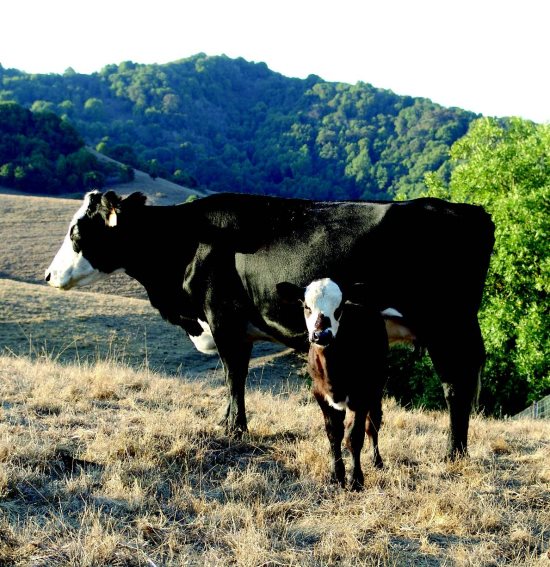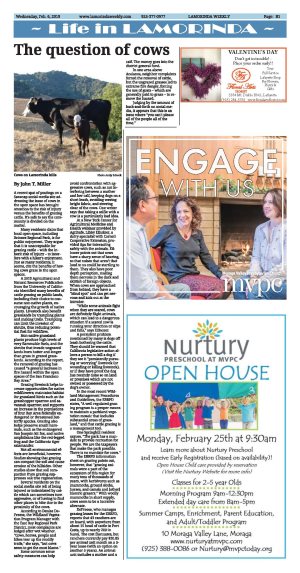| | Published February 6th, 2019
| The question of cows
| | | By John T. Miller |  | | Cows on Lamorinda hills Photo Andy Scheck |
A recent spat of postings on a Saranap social media site addressing the issue of cows in the open space has brought attention to the risk of injury versus the benefits of grazing cattle. It's safe to say the community is divided on the matter.
 Many residents claim that local open space, including Briones Regional Park, is for public enjoyment. They argue that it is unacceptable for grazing cattle - with the inherit risk of injury - to interfere with a hiker's enjoyment. Just as many residents, it seems, cite the benefits of having cows graze in the open spaces.
Many residents claim that local open space, including Briones Regional Park, is for public enjoyment. They argue that it is unacceptable for grazing cattle - with the inherit risk of injury - to interfere with a hiker's enjoyment. Just as many residents, it seems, cite the benefits of having cows graze in the open spaces.
 A 2015 Agricultural and Natural Resources Publication from the University of California identified many benefits of cattle grazing on public lands, including their choice to consume non-native plants, encouraging the growth of native plants. Livestock also benefit grasslands by trampling plants and making trails. Trampling can limit the invasion of shrubs, thus reducing potential fuel for wildfires.
A 2015 Agricultural and Natural Resources Publication from the University of California identified many benefits of cattle grazing on public lands, including their choice to consume non-native plants, encouraging the growth of native plants. Livestock also benefit grasslands by trampling plants and making trails. Trampling can limit the invasion of shrubs, thus reducing potential fuel for wildfires.
 Non-native grassland plants produce high levels of very flammable fuels, and the shrubs that invade ungrazed lands burn hotter and longer than grass in grazed grasslands. According to the report, the removal of grazing has caused "a general increase in fire hazard within the open spaces of the San Francisco Bay Area."
Non-native grassland plants produce high levels of very flammable fuels, and the shrubs that invade ungrazed lands burn hotter and longer than grass in grazed grasslands. According to the report, the removal of grazing has caused "a general increase in fire hazard within the open spaces of the San Francisco Bay Area."
 Grazing livestock helps increase opportunities for native wildflowers; maintains habitat for grassland birds such as the grasshopper sparrow and savannah sparrow; and supports an increase in the populations of four Bay Area federally endangered or threatened butterfly species. Grazing also helps preserve small mammals, such as the endangered San Joaquin kit fox, and native amphibians like the red-legged frog and the California tiger salamander.
Grazing livestock helps increase opportunities for native wildflowers; maintains habitat for grassland birds such as the grasshopper sparrow and savannah sparrow; and supports an increase in the populations of four Bay Area federally endangered or threatened butterfly species. Grazing also helps preserve small mammals, such as the endangered San Joaquin kit fox, and native amphibians like the red-legged frog and the California tiger salamander.
 Not all environmental effects are beneficial, however. Studies showing that grazing can compact the soil and cause erosion of the hillsides. Other studies show that soil compaction from grazing suppresses oak tree regeneration.
Not all environmental effects are beneficial, however. Studies showing that grazing can compact the soil and cause erosion of the hillsides. Other studies show that soil compaction from grazing suppresses oak tree regeneration.
 Several residents on the social media site tell of being injured or intimidated by cattle which can sometimes turn aggressive, or of having to find other places to hike due to the proximity of the cows.
Several residents on the social media site tell of being injured or intimidated by cattle which can sometimes turn aggressive, or of having to find other places to hike due to the proximity of the cows.
 According to Denise DeFreese, the Wildland Vegetation Program Manager with the East Bay Regional Park District, most complaints are lodged after wet weather. "Cows, horses, people and bikes tear up the muddy trails," she says, "but cows seem to get the most blame."
According to Denise DeFreese, the Wildland Vegetation Program Manager with the East Bay Regional Park District, most complaints are lodged after wet weather. "Cows, horses, people and bikes tear up the muddy trails," she says, "but cows seem to get the most blame."
 Some common sense safety measures can help avoid confrontation with aggressive cows, such as not interfering between a mother and her calf, keeping dogs on a short leash, avoiding waving bright fabric, and steering clear of the cows. One writer says that taking a selfie with a cow is a particularly bad idea.
Some common sense safety measures can help avoid confrontation with aggressive cows, such as not interfering between a mother and her calf, keeping dogs on a short leash, avoiding waving bright fabric, and steering clear of the cows. One writer says that taking a selfie with a cow is a particularly bad idea.
 At a New York Center for Agricultural Medicine and Health webinar provided by AgriSafe, Libby Eiholzer, a dairy specialist with Cornell Cooperative Extension, provided tips for interacting safely with the animals. Eilhozer points out that cows have a sharp sense of hearing, so that noises that aren't that loud to us could be startling to them. They also have poor depth perception, making them nervous in the dark and skittish of foreign objects. When cows are approached from behind, they have a "blind spot" and can get nervous and kick out at the intruder.
At a New York Center for Agricultural Medicine and Health webinar provided by AgriSafe, Libby Eiholzer, a dairy specialist with Cornell Cooperative Extension, provided tips for interacting safely with the animals. Eilhozer points out that cows have a sharp sense of hearing, so that noises that aren't that loud to us could be startling to them. They also have poor depth perception, making them nervous in the dark and skittish of foreign objects. When cows are approached from behind, they have a "blind spot" and can get nervous and kick out at the intruder.
 "While some animals fight when they are scared, cows are definitely flight animals, which can lead to a dangerous situation if a scared cow is running your direction or slips and falls," says Eilhozer.
"While some animals fight when they are scared, cows are definitely flight animals, which can lead to a dangerous situation if a scared cow is running your direction or slips and falls," says Eilhozer.
 A persistent problem mentioned by many is dogs off leash bothering the cattle. They should be warned that California legislative action allows a person to kill a dog if they see it "persistently pursuing or worrying" livestock (or wounding or killing livestock), or if they have proof the dog has recently done so on land or premises which are not owned or possessed by the dog's owner.
A persistent problem mentioned by many is dogs off leash bothering the cattle. They should be warned that California legislative action allows a person to kill a dog if they see it "persistently pursuing or worrying" livestock (or wounding or killing livestock), or if they have proof the dog has recently done so on land or premises which are not owned or possessed by the dog's owner.
 In the most recent Wildland Management Procedures and Guidelines, the EBRPD states, "A well regulated grazing program is a proper means to maintain a parkland vegetation mosaic that includes substantial areas of grassland," and that cattle grazing is a management tool.
In the most recent Wildland Management Procedures and Guidelines, the EBRPD states, "A well regulated grazing program is a proper means to maintain a parkland vegetation mosaic that includes substantial areas of grassland," and that cattle grazing is a management tool.
 One Springhill resident argues, "The park has a mandate to provide recreation for people. We are the taxpayers that make the park possible. There is no mandate for cows."
One Springhill resident argues, "The park has a mandate to provide recreation for people. We are the taxpayers that make the park possible. There is no mandate for cows."
 The EBRPD information sheet on grazing points out, however, that "grazing animals were a part of the ecosystem of this region for many tens of thousands of years, with herbivores such as mammoths, ground sloths, horses, and camels and [other] historic grazers." With woolly mammoths in short supply, cows seem to be a lucrative alternate.
The EBRPD information sheet on grazing points out, however, that "grazing animals were a part of the ecosystem of this region for many tens of thousands of years, with herbivores such as mammoths, ground sloths, horses, and camels and [other] historic grazers." With woolly mammoths in short supply, cows seem to be a lucrative alternate.
 DeFreese, who manages grazing leases for the EBRPD, reports that 43 ranchers are on board, with anywhere from about 15 head of cattle in Port Costa, up to nearly 200 in Sunol. The cost fluctuates, but ranchers currently pay $20.85 per animal unit month on a 5-year lease (with an option on another 5 years). An animal unit includes a mother and a calf. The money goes into the district general fund.
DeFreese, who manages grazing leases for the EBRPD, reports that 43 ranchers are on board, with anywhere from about 15 head of cattle in Port Costa, up to nearly 200 in Sunol. The cost fluctuates, but ranchers currently pay $20.85 per animal unit month on a 5-year lease (with an option on another 5 years). An animal unit includes a mother and a calf. The money goes into the district general fund.
 In one area above Acalanes, neighbor complaints forced the removal of cattle, but the ungrazed grasses led to extreme fire danger, forcing the use of goats - which are generally paid to graze - to remove the hazard.
In one area above Acalanes, neighbor complaints forced the removal of cattle, but the ungrazed grasses led to extreme fire danger, forcing the use of goats - which are generally paid to graze - to remove the hazard.
 Judging by the amount of back-and-forth on social media, it appears that this is an issue where "you can't please all of the people all of the time."
Judging by the amount of back-and-forth on social media, it appears that this is an issue where "you can't please all of the people all of the time." |
| | | | | | | | | | | | |



